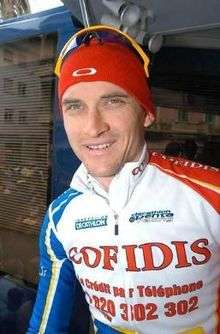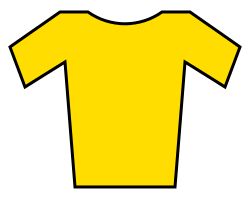Andrey Kivilev
 | |
| Personal information | |
|---|---|
| Full name | Андрей Кивилев |
| Born |
September 20, 1973 Taldykorgan, Kazakhstan |
| Died |
March 12, 2003 (aged 29) Saint-Etienne, France |
| Team information | |
| Discipline | Road |
| Role | Rider |
| Professional team(s) | |
| 1998–1999 | Festina-Lotus |
| 2000 | Ag2r |
| 2001–2003 | Cofidis |
| Major wins | |
| Route du Sud (2001) | |
|
Infobox last updated on July 25, 2007 | |
Andrei Kivilev (September 20, 1973 – March 12, 2003) was a professional road bicycle racer from Taldykorgan, Kazakhstan. In March 2003, he crashed during the Paris–Nice race and subsequently died of his injuries. His death was the trigger for the UCI to implement the compulsory wearing of helmets in all endorsed races.
Career
Born in Taldykorgan, Almaty Province, Kivilev began his amateur racing career in Spain, before moving to France, where he wore the EC Saint-Etienne jersey.[1] In 1993, he had a successful Regio-Tour as part of a successful tour for the Kazakh team: Kivilev won the points competition; team mate Alexander Vinokourov won the combined competition; and the team won the team competition.[2] He secured a professional contract with Festina in 1998 and rode with them until the end of 1999. Kivilev had a modest time at Festina, where his best results were fifth at the Championship of Zurich[3] and seventh at the Critérium International.[4] Despite his lack of professional victories, Kivilev attracted admirers for his riding style, and despite interest from US Postal Service,[5] signed with Ag2r Prévoyance in 2000, before moving to Cofidis in 2001. It was at Cofidis that his career started to take off: in his first season, not only did he win the Route du Sud and stage five of the Dauphiné Libéré race, between Romans-sur-Isère and Grenoble,[6] but also had a sensational performance in the Tour de France. Having lost over eighteen minutes on a windswept and attritional stage 4 between Huy and Verdun,[7] Kivilev was allowed to form part of a fourteen-man breakaway on stage 8 between Colmar and Pontarlier and gained 33 minutes on the race favourites.[8] Kivilev was an able climber, and limited his losses on the big hills. His time trialling let him down when he lost a podium place to Joseba Beloki on the final time trial. Nevertheless, Kivilev finished the tour in 4th position.[9] In fact, with later doping scandals eliminating those ahead of him on the podium, the French newspaper Le Monde retroactively (and unofficially) named Kivilev winner of the 2001 Tour de France.[10]
Death
On March 11, 2003, Kivilev was racing in the second stage of Paris–Nice, between La Clayette and Saint-Étienne. Approximately forty kilometres from the stage finish, as the peloton passed through Saint-Chamond, Kivilev collided with Polish teammate Marek Rutkiewicz and German Volker Ordowski of Team Gerolsteiner, although they were not seriously hurt and finished the stage. The helmetless Kivilev hit the ground and did not rise. Kivilev immediately fell into a coma, initially being taken to the Saint-Chamond hospital before being transferred via air to the intensive care unit at Saint-Étienne hospital, where he was diagnosed with a serious skull fracture and two broken ribs. His condition worsened overnight, and Kivilev died of his injuries at 10 a.m. on March 12, 2003. He was survived by his wife Natalia and six-month-old son Leonardo. A few days later his friend, Alexander Vinokourov, won the race.
Legacy
After Kivilev's death, the UCI made the wearing of helmets compulsory.[11] They had previously tried to introduce this requirement in 1991, however, riders protested this at the Paris–Nice race, so the rule was not introduced. The nature of Kivilev's death, in that he was a lead rider, in one of the top French cycling teams, racing in a top stage race, coupled with advances in helmet technology, brought the debate back to the fore and conclusively so for the UCI. Whilst many riders were initially still against compulsory helmet use, the UCI ensured the rules requiring helmets to be worn at all times would be in place for the 2003 Giro d'Italia, which started just eight weeks after Kivilev's death. Dissension to the rule was initially high. The new rules were affirmed in October 2003. Whilst at first the rule was loose and not tightly enforced, especially on mountain-top finishes, it has since been enforced more and helmet-wearing is now ubiquitous in the peloton.
Palmarès
- 1995
- 1st
 Overall Tour of Turkey
Overall Tour of Turkey - 1998
- 2nd Overall Vuelta Ciclista de Chile
- 2001
- 1st
 Overall Route du Sud
Overall Route du Sud - 4th Overall Tour de France
- 5th Overall Critérium du Dauphiné Libéré
- 1st Stage 5
- 2002
- 3rd Overall Route du Sud
- 4th Clásica de San Sebastián
- 4th Overall Paris–Nice
- 5th Overall Critérium du Dauphiné Libéré
- 2003
- 3rd Tour du Haut Var
References
- ↑ Fabio (2003-03-12). "Andrei Kivilev". Daily Peloton – Pro Cycling News. Archived from the original on 5 September 2006. Retrieved 2006-09-12.
- ↑ "19th Rothaus Regio-Tour International – Past Winner". Cyclingnews.com. 2003-08-06. Retrieved 2006-09-12.
- ↑ "Meisterschaft von Zürich, World Cup Round 8". Cyclingnews.com. 1999-08-22. Retrieved 2006-09-12.
- ↑ "Criterium International de la Route, Cat 2.2 Final GC after Stage 3". Cyclingnews.com. 1999-03-28. Retrieved 2006-09-12.
- ↑ "Andrei Kivilev: September 21, 1973 – March 12, 2003". Cyclingnews.com. 2003-03-20. Retrieved 2006-09-12.
- ↑ "53rd Criterium du Dauphiné Libére – Stage 5 Results". Cyclingnews.com. 2001-06-15. Retrieved 2006-09-12.
- ↑ Maloney, Tim (2001-07-11). "88th Tour de France – Stage 4". Cyclingnews.com. Retrieved 2006-09-12.
- ↑ Maloney, Tim (2006-07-15). "88th Tour de France, Stage 8 – Just another epic day to Pontarlier". Cyclingnews.com. Retrieved 2006-09-12.
- ↑ "Palmarès de Andrei KIVILEV (KAZ)". Bienvenue sur l'historique du Tour de France (in French). Amaury Sport Organisation. 2006-07-05. Archived from the original on 2006-09-05. Retrieved 2006-09-12.
- ↑ "Qui a vraiment gagné le Tour depuis 1999?". Le Monde. 2012-08-24. Retrieved 2012-08-28.
- ↑ Wheatcroft, Geoffrey (2003). Le Tour: a history of the Tour de France, 1903–2003. London: Pocket Books. p. 320. ISBN 0-7434-4992-4.
External links
- Andrey Kivilev profile at Cycling Archives